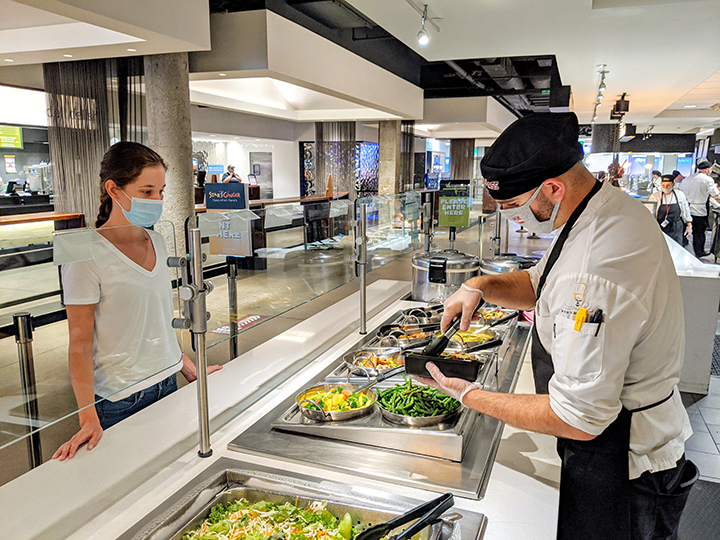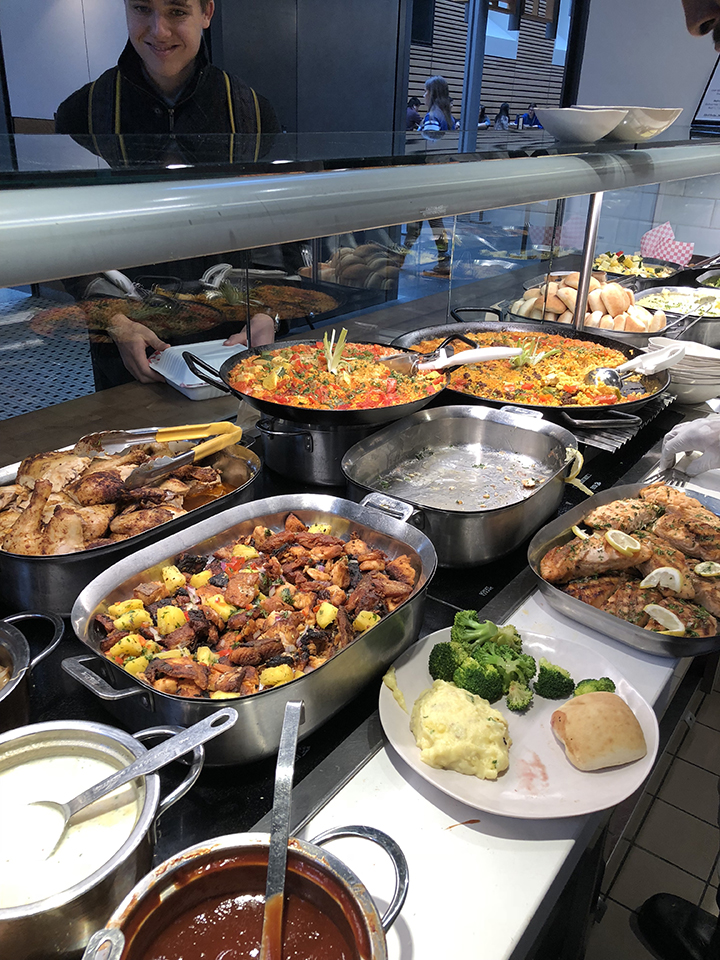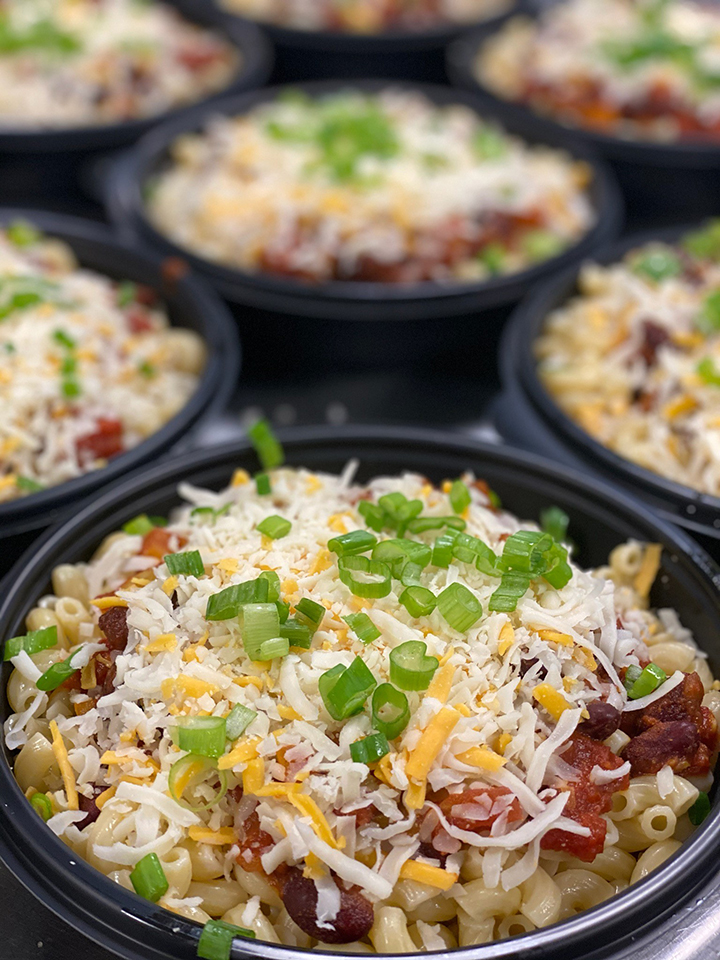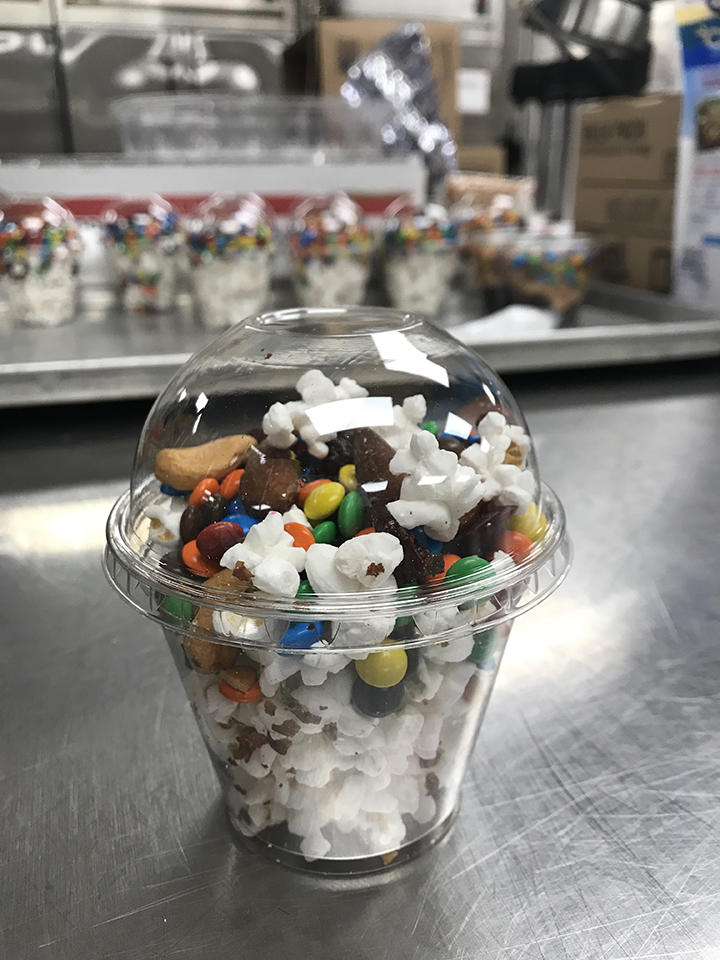Generation Z wants it all: delicious food, exciting flavors, anytime, anywhere—and why wouldn’t they? Those born in 1993 and later are in their young 20s, and they’re products of a fast-paced world. They’re active, with instant access to the world through their monitors, their tablets, their smartphones—even their watches. Overall, Generation Z comprises more than 25% of the current U.S. population, according to the American Egg Board’s white paper, A New Generation to Feed, so it’s essential to find ways to tap into the market.

Like many other colleges, the focus at the University of Massachusetts has shifted to Grab and Go. Photo courtesy Tara Fitzpatrick.
Even though campus dining will look very different this fall, the foods that Generation Z gravitate to, and the ways they prefer to eat, will remain largely unchanged.
“Generation Z will always be a very discerning customer base,” said Datassential’s Mark Brandau during Food Management’s recent “Back to School” webinar series. “This is a pretty resilient group of customers, so they will be able to handle a lot right now.”
A is for all of the options
When it comes to food, Generation Z has a flair for adventure, while also looking for customization and variety. This generation enjoys experimenting with creative food fusions, flavors, and health options; while also experimenting with new styles of diets or fads, such as gluten-free, vegetarian, paleo, or dairy-free.
“Colleges were hyper into customization,” says Tara Fitzpatrick, Senior Editor for the Restaurant and Food Group. “Everyone was a chef.”

Duke University offers a number of different roasted options to choose from. Photo courtesy Tara Fitzpatrick.
But what are some of the contributing factors to Gen Z’s food preferences?
“They have traveled, and they have eaten out a lot,” says Beth Emery, Director of Dining Services for Boston College. According to A New Generation to Feed, Generation Z’s appetites largely gravitate toward:
- Breakfast all day comfort foods from a wide range of ethnicities
- More authentic and varied global offerings, such as Mediterranean, Southeast Asian, Korean, and Middle Eastern
- Hot, spicy, and more adventurous flavors
- Plant-based menus
Here we will look at three of the most common food trends among Generation Z: comfort food with a global influence, healthy and sustainable foods, and smaller portion sizes.
When global meets comfort
As the whole world attempts to cope with the stress of COVID-19, the idea of seeking comfort in food has become a sort of lifeline, and Generation Z isn’t any different. According to statistics from Food Management, 23% of Generation Z is eating more comfort food.
“There’s that comfort factor of making people feel good with food,” Fitzpatrick says. “Kids are away from home, they’re homesick, so they’re missing certain types of food.”

French Toast, such as this option at Northewestern University, or any brunch items are great additions to any menu because of their sense of comfort. Photo courtesy Tara Fitzpatrick.
For many people, the thought of comfort food might bring to mind visions of grilled cheese, meat loaf, lasagna, and other heartier, American dishes that evoke feelings of home. However, the definition of comfort food and homestyle cooking for Generation Z includes so much more.
“Generation Z is one of the most ethnically diverse populations,” says Sheryl Thompson, a General Manager for one of Boston College’s dining halls, “so of course they want more ethnic, more global—they’re looking for dishes that remind them of places they’ve traveled.”
According to A New Generation to Feed, almost half (48%) of Generation Z is listed as nonCaucasian. Additionally, this group also has been brought up with certain expectations regarding food having been raised in cultures that entertain with and celebrate food.
Some of the popular global dishes that fall under the umbrella of comfort food range from Korean barbecue to burritos to samosas to sushi to curries and everything in between. Flavor & The Menu magazine cites yuzu, tamarind, lemongrass, and vinegar as flavors that are on the rise and expected to gain in popularity among Generation Z.
Go green
Above all, Generation Z is in search of food that is fresh, authentic, ethically sourced, and sustainable. Additionally, they are more likely to embrace flexitarian dining, with vegetables as the star of the show, coupled with a complementary protein. According to A New Generation to Feed, 79% of Generation Z wishes to go meatless more often. Additionally, almost half (41%) of Gen Z say they would pay more for foods they perceive as healthier, compared to 32% of millennials, according to a Tufts Nutrition Report.
“Most students are really health conscious and looking for healthier alternatives to the old-style expectations of dining halls,” says Michael Gaidusek, Campus Executive Chef at the University of Florida.

For the plant-based side of the menu. vegetarian chili mac has been providing a hearty meal option at Missouri University of Science & Technology, Photo couresy Tara Fitpatrick.
Some of the most popular food items at a number of different college dining halls include acai bowls, greens bowls, grain bowls, stuffed avocados, and various vegetable wraps. There’s even an opportunity to bring in a global element with vegetarian dishes as well through the use of different spices. With various spice blends, “you can incorporate those global flavors in a different way,” Thompson says.
Less is more
Generation Z grew up during the height of the tapas craze, which could be why they are more likely to put together a meal of smaller components such as appetizers and small plates, rather than sit down for one big gut-busting meal. In fact, 23% of Generation Z say they prefer to build a meal of appetizers or snack foods, according to A New Generation to Feed. Compare that to Food Management’s data that shows that 29% of Generation Z are turning more toward snacking in response to COVID-19.
“The future of dining is not bulk portions,” Gaidusek says. “Students nowadays do not care for a giant plate of food.”

A popcorn snack from Bryan Medical Center. Photo courtesy Tara Fitzpatrick.
Generation Z’s tendency toward snacking has also given rise to another trend, which we’ll dive into next: convenience.
“There could be pretty good opportunities for an off-premise offering around snacking by incorporating healthy snacks such as protein-forward or nut-based snacks,” says Brandau. “Snacking and health can overlap more than you think.”
Z is for zero inconvenience
What Generation Z eats is just as important as how tech-savvy Generation Z eats. Consider these statistics from a recent Food Management survey: 67% of colleges are adding or increasing the use of mobile ordering; 40% are adding or increasing the use of delivery; and 91% are increasing grab and go options.
“The students who come to our campus today have grown up with GrubHub, DoorDash, and EatStreet, and they’re used to having that convenience of food being brought to them whenever, wherever they want,” said Peter Terstory from the University of Wisconsin-Madison during the “Back to School” webinar series. “They’re going to want the service; they’re going to want convenience.”
There are so many different options for setting up a convenient delivery or grab and go program, whether that’s through partnerships with third party delivery services, utilizing staff, or hiring outside student drivers. Some colleges have even invested in fully-automated delivery robots, like the University of Wisconsin-Madison.
“You can’t talk about a more contactless delivery option than putting food into a robot,” Terstory says. “[Our students’] lives are extremely hectic and they’re juggling a lot of things, so by offering delivery we are giving them the gift of time.”

University of Massachusetts students enjoy their lunch while social distancing. Photo courtesy Tara Fitzpatrick.
Beyond the convenience of food delivery, Generation Z also wants the convenience of customization.
“What they care about is that they have input in making their food,” Gaidusek says. “They decide which sauces, which grains, which vegetables, which meats they want to eat. The most important thing is giving them the creativity to have it made the way they want it. As I build menus, I constantly look at them and think, ‘How I can give more options, more variety and create a unique experience that excites our guests every time they dine with us?’”
The needs of Generation Z will constantly evolve. “We really need to be on trend and looking out for what’s out in the marketplace,” Emery says. “This generation is exposed to so many more types of really good food.”
Editor’s note: The publication, Food Management and the Restaurant and Food Group is owned and operated by Informa Connect, Catersource’s parent company.



